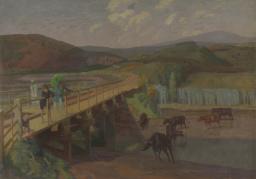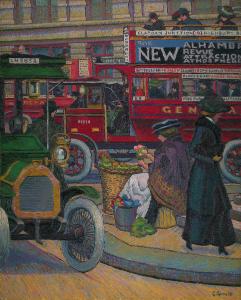G.R.H., ‘Gallery and Studio. The Camden Town Group’
Pall Mall Gazette, 12 December 1912, p.7.
GALLERY AND STUDIO.
THE CAMDEN TOWN GROUP.
Again, for the third time, to the Carfax Gallery in Bury-street, the “Camden Town Group” of painters has brought its sheaves, and one gathers that the annual harvest has not been particularly brilliant. The little gallery certainly “sings” with colour, but there are discords as well as harmonies, and the whole is dominated by a rather foolish adventure in the Futurist manner – the fruits of a perverted theory rather than of observation – and fatally destitute in humour.
It is to Mr. Walter Sickert, Mr. Walter Bayes, and Mr. Henry Lamb that the interest of the exhibition belongs, and these gentlemen have no logical or technical connection with the group from Camden Town. They are artists and not theorists. Each of the three has developed a personality of his own, and is not tied to any apron-strings. They have passed their dangerous age of irresponsible experiment, and do not seek to interest by the assumption of eccentricity or a deliberate naïveté. In short, the fundamental destruction between these three and all the rest lies in their attitude towards the public. The Camden Town group beats drums and plays all kinds of instruments to attract attention and gain applause, whilst Mr. Walter Sickert, for example, remains serenely (and very consciously) contemptuous of popular opinion; indeed, one can only guess at his reasons for showing his pictures. To paint a painfully candid nude woman, and a quite recognisable British working-man, seated on either side of a bed in a dark interior, and then to call your picture “Summer in Naples” is a surprising descent even for Mr. Sickert. It is certainly unkind to those humble defenders of his who do not as a rule need any titles, baffling or otherwise, to point the way through Mr. Sickert’s erratic and querulous tapestries. A study of a child, which the artist calls “Chicken,” is in an impulsive and wayward mood, but the instinct for selection has not slept, and so life is captured in a masterly ellipsis, which may not recognise conventional elegance or grace, but is deeply concerned with elemental facts of stability and vibrating colour. Mr. Sickert still prides himself on his audacity in ugliness, but one does not look for conversion at this late hour.
Mr. Henry Lamb.
Two heads of children by Mr. Henry Lamb have a Raphaelesque largeness of contour, but are both a little empty in their content. They have the shapes but not the charm or freshness of childhood. One feels the intellectual effort rather than the emotion of the artist; they are phlegmatic and heavy-handed in modelling, with an impassive, stolid look that misses the quickening pulse of youth, and they are both bare in texture. But Mr. Lamb is a very clever young artist, whose affectations may chill his admirers but do not destroy their hopes of more subtle work when experience has given him greater freedom in handling. The Slade school still haunts him.
Mr. Walter Bayes.
Mr. Walter Bayes is very decidedly among the freshest and brightest influences in current painting. I only record my own experience, but his pictures are to me always points of interest which stand apart in an exhibition. It is personality, of course, for Mr. Bayes is almost the equal of Mr. John in his isolation, and, one may add, in this connection, he far surpasses Mr. John in his ability to keep his composition consistently lyrical without any breaks in rhythm or tone. He attracts first by his refinement and graceful colour, and next by his well-arranged shapes and their reconciliation with natural fact. He is not very much interested in character, not very strong in the plastic sense – lacking in massiveness and weight – but he is a charming decorator, who fills up his space with ingenious patterns, and he is tremendously concerned with light. In “Shade,” Mr. Bayes has tackled the difficult problem of matching local values in shadow and in expressing those wavering masses that half elude the eye when it passes from the glare of sunlight. The result is a beautiful picture, tender and dignified: green bathing coaches and figures under trees contrasted with the brilliance of a summer sea and sky. A larger picture of more conventional design is composed in a classical manner, rich and dignified in colour, but a little thin in handling, and, like all of Mr. Bayes’s present work, rather lacking in depth.
Other Exhibitors.
Mr. Lucien Pissarro is the dominating note among the other exhibitors. His somewhat dry and naïve method is the example which more than one of the group has followed. The best of his own contributions is a snow scene, “Stamford Brock [sic] Green.” A bright little French harbour in the style of Boudin by Mr. J. B. Manson may be noted, but I prefer a dexterous, short-hand sketch by the same artist, “Moonlight and Snow.” There is no refinement of colour or grace of drawing in four blatant London subjects by Mr. H. [sic] C. Drummond, which irritate by the empty glare of their gaudy tints. A gold and green pond by Mr. S. F. Gore is rhythmical in design, and Mr. C. Ginner’s “Piccadilly Circus,” both in its crude tones and jumbled composition, happily suggests the noise and confusion of that busy thoroughfare. Finally, Mr. R. P. Bevan’s horsey subjects are both slick and humorous, but on the whole there is no overwhelming evidence in the exhibition that Camden Town affords a specially fertile soil for the cultivation of the Fine Arts.
The “Art Annual.”
The “Art Annual” for Christmas, published by Messrs. Virtue and Co., contains many fine reproductions after the pictures of Mr. Joseph Farquharson, A.R.A., with an appreciation of that artist by Archdeacon Sinclair, D.D. The plates in black and white seem to give a better idea of the pictures than those reproduced in colour. Mr. Farquharson’s art is well known and very popular, and his biographer tries to do him full justice. One is conscious of a certain monotony in these pictures, especially in the particular breed of sheep which Mr. Farquharson affects, and in his recurring mood of sentimentalism. But the public seems to enjoy both, and Archdeacon Sinclair is most emphatically of opinion that the public is right.
G. R. H.
How to cite
G.R.H., ‘Gallery and Studio. The Camden Town Group’, in Pall Mall Gazette, 12 December 1912, p.7, in Helena Bonett, Ysanne Holt, Jennifer Mundy (eds.), The Camden Town Group in Context, Tate Research Publication, May 2012, https://www


